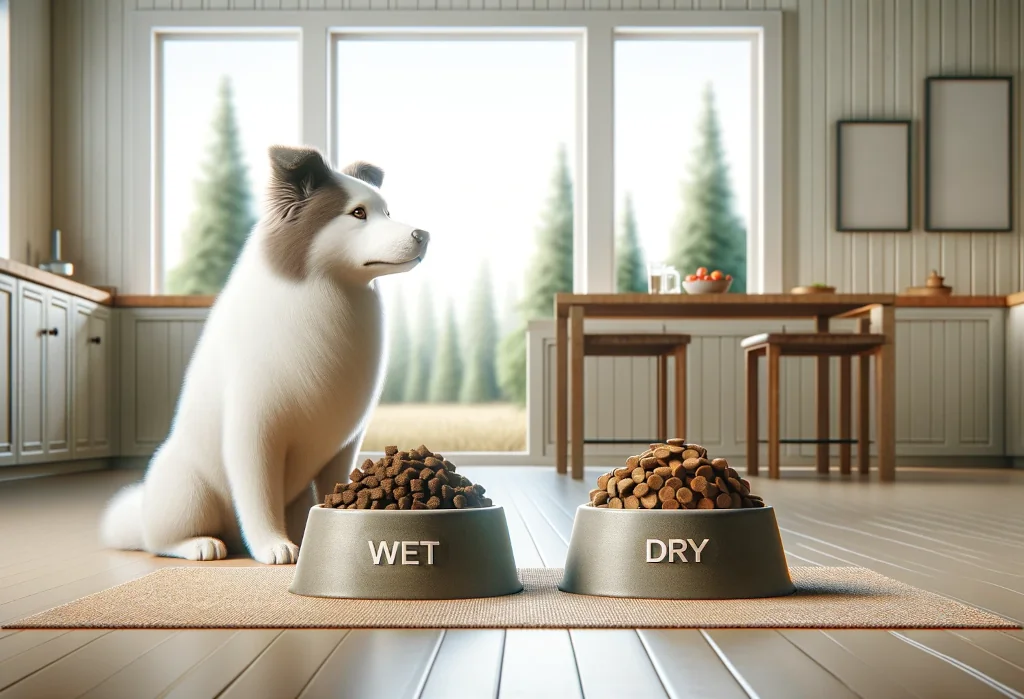Choosing the right food for your furry friend feels like solving a puzzle in the dark, doesn’t it? With so many shelves stacked with bags and cans, it’s easy to wish your dog could just speak up and tell you what they want.
This post will simplify the daunting task of picking the perfect meal for your pooch. You’ll walk away knowing the ins and outs of dog nutrition, confident in making an informed choice.
Key takeaways:
- Assessing dog food’s nutritional value starts with the ingredient list; opt for whole foods near the top and check for AAFCO compliance.
- Dry food offers convenience and dental benefits, while wet food is better for hydration and picky eaters—consider your dog’s needs first.
- Transition between different food types gradually, and establish mealtime rituals to enhance digestion and enjoyment.
Dry vs. Wet Dog Food: What’s the Real Difference?
When you stroll down the pet food aisle, the plethora of choices can feel a bit like standing at a crossroads. The shelves are stacked with bags of dry kibble and cans of wet food, each boasting about their nutritional benefits. So, what really sets them apart?
Dry dog food , also known as kibble, is created by mixing and cooking ingredients like meat, grains, and veggies. This mixture is then shaped into bite-sized pieces. The perks? It’s convenient, often more affordable, and has a long shelf life without the need for refrigeration.
Wet dog food , on the flip side, contains a higher moisture content, which can be great for hydration. It’s typically more appealing to picky eaters due to its rich flavors and scents. The downside? It’s usually pricier and, once opened, requires refrigeration and prompt consumption.
Both types have their nutritional merits when formulated properly. The real trick lies in selecting a high-quality option that meets your furry friend’s dietary needs.
Here’s a quick comparison table to help you weigh the pros and cons of dry and wet dog food at a glance:
| Aspect | Dry Dog Food (Kibble) | Wet Dog Food |
|---|---|---|
| Moisture Content | Low | High |
| Convenience | High (easy storage) | Lower (requires refrigeration) |
| Cost | Generally more affordable | More expensive |
| Shelf Life | Long | Short after opening |
| Dental Health | Promotes better dental health (reduces plaque) | Less dental benefits |
| Hydration | Lower hydration | Aids in hydration |
| Palatability | Less appealing to some dogs | Often more appealing (rich flavors) |
| Nutritional Density | Can vary | Often higher protein content |
The above table provides a clear snapshot of the fundamental differences between dry and wet dog food. When selecting food for your dog, consider factors like dietary needs, lifestyle, and any specific health concerns. For instance, a highly active dog might benefit from the dense nutritional content in wet food. Similarly, wet food’s softer texture is beneficial for dogs with dental sensitivities, making it easier to eat, though dry kibble might help with plaque. Remember, your dog’s preference and overall health are paramount in this choice.
How Do I Evaluate the Nutritional Value of Dog Food?
Unlocking the nutritional secrets of your dog’s food begins with a peek at the label. Here’s the scoop on making sense of what’s printed on the packaging:
- Ingredient List: Ingredients are listed in order of weight. Look for whole foods near the top of the list, as this indicates a higher quality. For instance, seeing “chicken” or “beef” as the first ingredient is a good sign.
- AAFCO Statement: The Association of American Feed Control Officials sets nutritional standards for pet food. A statement from AAFCO on the label means the food meets these minimum nutritional requirements. Make it a point to look for this gold standard in pet nutrition.
Pro Tip : A unique insight many folks miss is the significance of the “guaranteed analysis” on the label. This part breaks down the minimum percentages of protein and fat, alongside the maximum percentages of fiber and moisture. It’s your quick snapshot of the food’s nutritional blueprint.
For a deep dive into reading pet food labels, consider visiting the AAFCO’s official website (AAFCO.org) or the FDA’s pet food labeling guide.
Can Dry Dog Food Meet All My Dog’s Needs?
The short answer? Yes, but there’s more to the story. Let’s chew over some of the undeniable perks of kibble:
- Convenience: There’s no beating the ease of scooping kibble into a bowl. Plus, it’s exceptional for on-the-go feeding.
- Dental Benefits: Crunching on dry food can help scrape away plaque, contributing to better dental health.
- Cost-Effectiveness: Generally, dry dog food offers more bang for your buck, especially when buying in bulk.
However, not all kibble is created equal. The quality of dry dog food spans a wide spectrum. A key to ensuring your dog’s diet is balanced includes integrating fresh or wet food for moisture, considering a supplement if advised by your vet, and choosing a premium dry food with quality ingredients.
At this point, you might wonder if a dry diet can cater to every pooch’s palate and health requirements. The answer largely hinges on the individual dog — their age, breed, health conditions, and personal taste preferences play pivotal roles. For example, certain breeds may benefit from specific nutrient blends, while older dogs might need a softer texture that wet food offers.
Selecting the right dog food ultimately boils down to understanding your dog’s unique needs and prioritizing high-quality ingredients. Whether you opt for dry kibble, wet food, or a mix of both, the goal is the same: to nourish your four-legged friend for a happy, healthy life.
Remember, transitioning your dog to a new food should be a gradual process. And when in doubt, having a chat with your vet can provide personalized guidance tailored to your dog’s dietary needs.
Is Wet Dog Food Better for My Dog’s Health?
When it comes to pampering our furry friends with the right diet, the wet food versus dry food debate takes center stage. Is wet dog food a healthier choice for your dog? Let’s dive in.
Wet dog food often contains higher moisture content than its dry counterpart, which is fantastic for hydration. Dogs, especially those who aren’t keen on drinking water or breeds prone to urinary tract issues, can significantly benefit from the extra moisture in wet food. Furthermore, wet food tends to have fewer fillers and more protein, meaning your dog is getting a denser nutritional value per bite.
Certain dogs might find wet food more appealing and easier to digest, such as:
-
Senior dogs: Older dogs may have dental issues or decreased jaw strength, making chewing dry food a challenge. Wet food is softer and easier on their teeth.
-
Picky eaters: The aroma and texture of wet food are often more enticing to dogs with finicky appetites.
-
Dogs with specific health issues: If your vet has recommended a higher intake of specific nutrients or fewer carbohydrates, wet food can be an excellent way to meet these dietary needs.
However, it’s not just about the type of food. Quality matters immensely. Regardless of whether you choose dry or wet, opting for a product with wholesome ingredients, the right balance of nutrients, and appropriate for your dog’s life stage is crucial.
How to Make a Decision: Dry, Wet, or Both?
Deciding whether to feed your dog dry, wet, or a mix of both types of food can seem like navigating a minefield. But don’t worry, we’re here to help you through it with a paw-friendly guide.
A Mixed Diet: The Best of Both Worlds?
Combining dry and wet dog food can offer a balanced diet that leverages the benefits of both forms. Here’s how:
-
Varied texture and taste: This can keep mealtime exciting for your dog, encouraging good appetite and enjoyment of meals.
-
Balanced hydration: Adding wet food to the diet can help increase your dog’s overall water intake.
-
Economic and practical: Wet food can be more expensive and less convenient in terms of storage and shelf life. Mixing it with dry kibble can make for a more cost-effective and practical feeding solution without compromising on quality.
Transitioning Between Food Types
If you’re thinking of changing up your dog’s diet, keep these tips in mind:
-
Do it gradually: Introduce new food types slowly over a week or more, increasing the ratio of the new food while decreasing the old. This helps prevent digestive upset.
-
Monitor your dog’s health: Keep an eye on their energy levels, coat health, and weight. Adjust the diet as needed, and don’t hesitate to consult your vet for personalized advice.
-
Check the ingredients: Ensure both dry and wet foods are of high quality and meet your dog’s nutritional needs.
A Unique Tip Most Miss
One unique tip often overlooked is the importance of mealtime rituals. Dogs thrive on routine, and how you present their food can affect their digestion and enjoyment. For those mixing dry and wet food, try warming the wet food slightly and mixing it with the dry kibble to release the aromas and enhance palatability. Remember, never leave wet food out for too long to avoid spoilage.
Ultimately, the decision on whether to feed dry, wet, or a combination depends on your dog’s health, preferences, and lifestyle – and your convenience and budget. Offering a varied diet can be beneficial, but consistency is key to avoid gastrointestinal issues. Always discuss any major diet changes with your vet to ensure it aligns with your dog’s nutritional needs and health status. Happy feeding!
Alex, a passionate animal lover, has experience in training and understanding animal behavior. As a proud pet parent to two dogs and three cats, he founded AnimalReport.net to share insights from animal experts and expand his knowledge of the animal kingdom.





